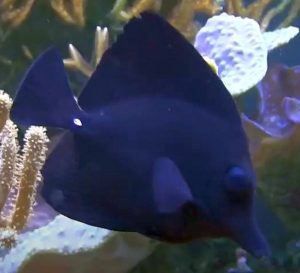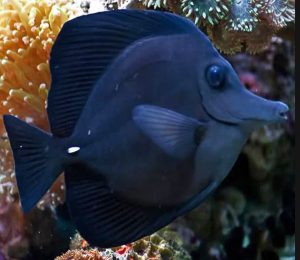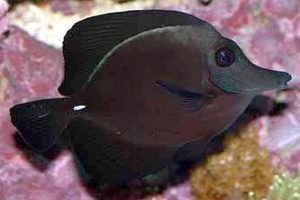The Black Tang (Zebrasoma rostratum) known to tropical fish keeping enthusiasts as the Black Longnose Tang, Longnose Surgeonfish, Longnose Tang, and Longnose Sailfin Tang is an uncommon species found in the western central Pacific Ocean.
In the Eastern Pacific, the Black Tang is found in the Line, Marquesas, Society, Tuamoto, and Pitcairn Island groups and range from Tuvalu, east to Pitcairn, including all of French Polynesia, north to the Line Islands and south to Rapa Iti. Specimens have also been recorded off Oahu in Hawaii.
The Black Longnose Tang is an active but relatively solitary benthopelagic species that can be found on the coral rich seaward reefs and rocky outcroppings of their range at depths from 3 to over 200 feet. Although adults are occasionally found in relatively shallow water, they prefer grazing on the deeper seaward reefs among rocky outcroppings.
Juveniles are typically found at shallower depths to 70 feet where they spend their days foraging on small invertebrates and filamentous algae among rocky structure and coral formations.
Juvenile Black Tangs are not totally black. They are gray towards the head and black on the posterior regions. As they mature into adulthood, their laterally compressed body turns into a deep dark brown to jet black color with subtle golden hues on the outer margins of their dorsal and anal fins, blue pectoral fins, and a bright diamond shaped white patch around the spines on the caudal peduncle.
Males develop a patch of bristles directly in front of the spines and both sexes possess an elongated snout that distinguishes them from their cousin, the Scopas Tang.
Around Hawaii where their range overlaps, the Black Tang (Zebrasoma rostratum) and the Scopas Tang (Zebrasoma scopas) are known to hybridize. The offspring have less elongated snouts, a bluish body color, slightly more yellow dorsal fins and eyes that appear more orange.
The Black Longnose Tang is best housed in an aged FOWLR or reef aquarium of at least 180 gallon capacity with a crushed coral or sandy substrate, substantial amounts of mature live rock arranged into caves, crevices, and overhangs for them to hide among, and plenty of free swimming space. The Black Tang is a peaceful fish that is perfectly suited for community tanks however they can become aggressive with other surgeonfish of their own genus.
In a FOWLR aquarium good tankmates include Clownfish, Dottybacks, Dartfish, Gobies, Blennies, Damselfish, and Anthias. They will also get along with Purple Tangs (Zebrasoma xanthurum), Powder Blue Tangs (Acanthurus leucosternon), and dwarf angelfish like the Flame Angelfish (Centropyge loriculus) and Coral Beauty Angelfish (Centropyge bispinosa) when added to the tank last. Non Zebrasoma species should be avoided.
Although Black Tangs are well suited for large reef systems and will generally ignore invertebrates and corals, a hungry specimen may occasionally nip on clam mantles and LPS corals.
Like all tangs, Zebrasoma rostratum need plenty of swimming area and highly oxygenated water with plenty of water flow to thrive; so a wave maker powerhead, a strong protein skimmer, good filtration, and regular water changes are mandatory to maintain their immune systems and prevent illness. In their natural environment, cleaner wrasses (Labroides sp.) remove parasites from their bodies, so adding a couple to the tank should also be considered.
As of this date, Black Tangs have not been bred in an aquarium environment.
In their natural habitat, Black Long Nose Tangs feed on various macro and micro algae, detritus, and small invertebrates. In an aquarium environment, tropical fish keeping enthusiasts should try to replicate their natural grazing behavior as closely as possible.
In addition to the live rock in the tank, they should be provided with plenty of seaweed, sheets of high quality marine algae, Spirulina, marine herbivore pellets, and occasionally some frozen meaty foods like brine shrimp and Mysis shrimp.
Although Black Tangs will eat meaty foods fed to the other fish in the aquarium, it is important that they are given plenty of fresh, frozen, or freeze dried marine based seaweed and algae to strengthen their immune systems, reduce aggression, and improve their overall well being.
Dried Nori tied to a rock or clipped in a veggie clip should be presented on a daily basis or at least three times a week. Sea Veggies, Seaweed Salad, and Ocean Nutrition are all ideal products that are convenient to use.
Because of its limited range, the Black Tang (Zebrasoma rostratum) is somewhat rare in the aquarium trade and demands a higher price than other Zebrasoma species. They are available on a waiting list basis from specialty fish shops and online from wholesalers, retailers, and trans shippers at the following approximate purchase sizes: Small: 1-1/2″ to 2-1/4″; Small/Medium: 2-1/4″ to 3-1/4″; Medium: 3-1/4″ to 4-1/4″; Medium/Large: 4-1/4″ to 5-1/4″ Large: 5-1/4″ to 6-1/4″ XLarge: 6-1/4″ to 7-1/4″.
Prices vary according to size and range from $1699.99 to over $3379.99.
Minimum Tank Size: 180 gallons
Aquarium Type: Reef or FOLR
Care Level: Moderate
Temperament: Peaceful to Semi-aggressive
Aquarium Hardiness: Very Hardy
Water Conditions: 74-78° F, dKH 8-12, pH 8.1-8.4, sg 1.020-1.025
Maximum Size: 8.3″
Color Form: Black, Blue
Diet: Omnivore
Compatibility: Reef or FOWLR
Origin: Easterhn and western central Pacific Ocean
Family: Acanthuridae
Lifespan: 10 – 15 years
Aquarist Experience Level: Intermediate





One Response to “Black Tang (Zebrasoma rostratum)”
Trackbacks/Pingbacks
[…] their range overlaps, the Scopas Tang (Zebrasoma scopas) and Black Tang (Zebrasoma rostratum) are known to hybridize. The offspring have less elongated snouts, a bluish body color, slightly more […]